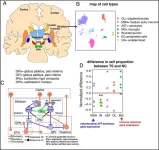(Press-News.org) Two mixtures of common food additives, including aspartame, sucralose, xanthan & guar gums, modified starches, carrageenan and citric acid, are linked with slightly increased risk of type II diabetes, per French cohort study of more than 100,000 adults
In your coverage, please use this URL to provide access to the freely available paper in PLOS Medicine: https://plos.io/3RkrNLv
Article title: Food additive mixtures and type 2 diabetes incidence: Results from the NutriNet-Santé prospective cohort
Author countries: France
Funding: see manuscript
END
Two mixtures of common food additives, including aspartame, sucralose, xanthan & guar gums, modified starches, carrageenan and citric acid, are linked with slightly increased risk of type II diabetes,
2025-04-08
ELSE PRESS RELEASES FROM THIS DATE:
Certain food additive mixtures may be associated with an increased risk of type 2 diabetes
2025-04-08
Food additive mixtures are an everyday feature of our diets, especially through ultra-processed foods. Until recently, safety evaluations of these additives have been conducted substance by substance due to a lack of data on the effect of them ingested together. In a new study, researchers from Inserm, INRAE, Sorbonne Paris Nord University, Paris Cité University and Cnam, as part of the Nutritional Epidemiology Research Team (CRESS-EREN), examined the possible links between exposure to mixtures of ...
Mouse brains register the difference between touching something and being touched
2025-04-08
Though the sense of touch underlies how we and most other animals interact with the world around us, much remains unknown about how this sense is processed in the brain. Researchers from Heidelberg University and Ludwig Maximillan University Munich in Germany measured the neuronal activity differences between active touch and passive touch in mice. As reported April 8th in the open-access journal, PLOS Biology, the researchers find that active and passive touch are processed by different pathways in the brain.
Active touch can be thought of as grabbing something with your hand, while passive ...
Researchers identify safer pathway for pain relief
2025-04-08
University of Florida scientists have helped identify a novel drug compound that selectively activates pain-altering receptors in the body, offering a potentially safer alternative to conventional pain medications.
In a new study published in Nature Communications, researchers describe how this drug compound provides pain relief without the dangerous side effects commonly associated with opioids administered to patients. The National Institutes of Health funded the study.
The human body relies on three kinds of opioid receptors to regulate pain, much like traffic control systems on a busy highway. Understanding these pathways ...
Cleveland Clinic-led trial is the first to show a delay in confirmed disability progression in non-relapsing secondary progressive multiple sclerosis
2025-04-08
Tuesday, April 8, 2025, Cleveland: A Cleveland Clinic-led clinical trial of tolebrutinib, an investigational oral Bruton’s tyrosine kinase inhibitor, a group of drugs originally developed to treat lymphomas and related blood disorders, demonstrated a 31% delay in the onset of six-month confirmed disability progression (CDP) in patients with non-relapsing secondary progressive multiple sclerosis (SPMS).
The first peer-reviewed results of the Phase 3 HERCULES trial published online today in the New England Journal of Medicine and were simultaneously presented during a clinical trials plenary session at the American Academy of Neurology 2025 ...
Community Review Board votes against public health care merger in Oregon after doctors group raises concerns about university’s primate research center
2025-04-08
PORTLAND, Ore. — The Physicians Committee for Responsible Medicine is lauding a Community Review Board after it voted unanimously on Monday to reject a merger between Oregon Health & Science University (OHSU), which houses one of seven primate research centers left in the United States, and Legacy Health.
“Instead of showing a real focus on patient care and ethical behavior, OHSU has been wasting money on drug, alcohol, and sex experiments on monkeys, and the public knows it,” said Neal Barnard, MD, FACC, ...
Groundbreaking study reveals changes in brain cell composition and gene activity in Tourette syndrome
2025-04-08
Philadelphia, April 8, 2025 – In the first comprehensive, cell-by-cell analysis of brain tissue from individuals with Tourette syndrome, researchers have pinpointed exactly which cells are perturbed and how they malfunction, revealing how different types of brain cells are affected by the condition. Findings from this groundbreaking study in Biological Psychiatry, published by Elsevier, provide unprecedented insights into the interplay of different brain cell types in Tourette syndrome, suggesting new therapeutic directions.
What makes this study particularly groundbreaking ...
ALS drug effectively treats Alzheimer’s disease in new animal study
2025-04-08
Experimental drug NU-9 — a small molecule compound approved by the U.S. Food and Drug Administration (FDA) for clinical trials for the treatment of amyotrophic lateral sclerosis (ALS) — improves neuron health in animal models of Alzheimer’s disease, according to a new Northwestern University study.
Like ALS, Alzheimer’s disease also results from misfolded proteins that damage brain health. Rather than treating symptoms from specific diseases, NU-9 instead addresses the underlying mechanisms of disease. Results from the new study give scientists hope that the drug should demonstrate effectiveness in the common ...
Breakthrough research revolutionizing pulmonary hypertension treatment
2025-04-08
A recent publication in the International Journal of Cardiology, Pulmonary artery denervation in pulmonary hypertension: A comprehensive meta-analysis, has shed light on the potential of pulmonary artery denervation (PADN) as an innovative intervention for pulmonary hypertension (PH), a condition that places patients at risk for right heart failure and death. Co-authored by Dr. James Jenkins, a cardiologist at Ochsner Health, the study analyzed data from multiple clinical trials to assess the therapeutic and clinical impact of PADN ...
More CPR education planned for Charlotte community with The David & Nicole Tepper Foundation
2025-04-08
CHARLOTTE, April 8, 2025 — The American Heart Association and The David & Nicole Tepper Foundation (DNTF) have teamed up to increase bystander cardiopulmonary resuscitation (CPR) and automated external defibrillator (AED) education through the Association’s Nation of Lifesavers™ movement. DNTF’s $600,000 commitment to support training in Charlotte youth sports will help prepare coaches, athletes and sports leagues officials to respond immediately and appropriately in a cardiac emergency situation. DNTF’s gift will also support CPR education within the Mecklenburg County Sheriff’s Department as well as affordable housing communities.
“This ...
When protective lipids decline, health risks increase
2025-04-08
New research from Weill Cornell Medicine has uncovered a surprising culprit underlying cardiovascular diseases in obesity and diabetes—not the presence of certain fats, but their suppression. The study, published Feb. 25 in Nature Communications, challenges the conventional belief that a type of fat called ceramides accumulates in blood vessels causing inflammation and health risks. Instead, their findings reveal that when ceramides decrease in endothelial cells lining blood vessels, it can be damaging and cause chronic illnesses. Ironically, the findings ...



